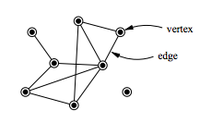
Photo from wikipedia
Disaster propagation in complex, interdependent, and multilayered networks has attracted considerable research interest in recent years. In this paper, we propose a model that combines two dynamic mechanisms, i.e., the… Click to show full abstract
Disaster propagation in complex, interdependent, and multilayered networks has attracted considerable research interest in recent years. In this paper, we propose a model that combines two dynamic mechanisms, i.e., the spreading of failure in layer-dependent networks, where each node in a layer depends on one in another layer. We first investigate the robustness of the Erdős-Rényi (ER)-ER, scale-free (sf)-ER, and sf-sf pattern of interdependent networks against cascading failure with different probabilities of triggering, and then use the random link, assortative link, and disassortative link patterns between the networks to analyze the scope of propagation of failure. The numerical results show that with increasing probability of triggering, the number of damaged nodes in both layers increased and the robustness of the scale-free network to random failures decreased due to the interdependence. Regardless of the topological structure, the two layers eventually tended to have similar failure characteristics due to their interdependence. In addition, the different link patterns had a significant effect on enhancing disaster propagation in interdependent networks.
Journal Title: Physical review. E
Year Published: 2022
Link to full text (if available)
Share on Social Media: Sign Up to like & get
recommendations!